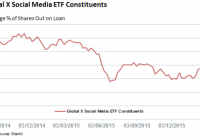Tech ETFs That Braved The Storm In February
Among other reasons, the month of February 20 16 will be remembered for the broad-based sell-off in the tech space. In any case, a retreat from high-growth stocks kept this space off the radar, but the tension flared up when LinkedIn Corp. (NYSE: LNKD ) issued a lackluster guidance for the first quarter of 20 16 in early February (read: LinkedIn Crashes: Should You Connect with Social Media ETF? ). Along with LinkedIn, the famous FANGs (Facebook (NASDAQ: FB ), Amazon (NASDAQ: AMZN ), Netflix (NASDAQ: NFLX ) and Google (NASDAQ: GOOG ) (NASDAQ: GOOGL ) (i.e. Alphabet) were also hit hard. Notably, the famous four contributed a lot to last year’s tech surge. However, the bloodbath in these stocks dragged down the tech-laden Nasdaq exchange, forcing it to be the worst performing index among the top three U.S. indices. Nasdaq- 100 ETF (NASDAQ: QQQ ) was off over 1.8% in February while Technology Select Sector SPDR ETF (NYSEARCA: XLK ) lost about 1%. Apart from the LinkedIn-induced crash, overvaluation concerns, global growth issues and corporate recession were responsible for last month’s technology tantrum. Almost all ETFs catering to cyber security, the broader Internet, cloud computing and software were the hardest hit in the technology meltdown. Still, there are a few tech ETFs which dared the sell-off to end the month in the green. Below we highlight three such tech ETFs. iShares North American Tech-Multimedia Networking ETF (NYSEARCA: IGN ) – Up 6.8% This ETF provides a concentrated exposure to the domestic multimedia networking securities by tracking the S&P North American Technology-Multimedia Networking Index. Holding 26 securities in its basket, Motorola (NYSE: MSI ) takes the top spot with a 9.5% allocation. This is followed by Qualcomm (NASDAQ: QCOM ) (9.35%) and Cisco Systems (NASDAQ: CSCO ) (8.7%). The product has a definite tilt toward small cap securities that account for 43%, followed by mid caps at 34%. It has accumulated $78.9 million in its asset base while sees a moderate volume of around 7 1,000 shares a day. Expense ratio comes in at 0.48%. The fund has a Zacks ETF Rank of 1 or ‘Strong Buy’ rating with a high risk outlook. PowerShares S&P SmallCap Info Tech ETF (NASDAQ: PSCT ) – Up 3.8% This fund tracks the S&P SmallCap 600 Capped Information Technology Index. It has amassed $377.5 million in its asset base and trades in average daily volume of about 4 1,000 shares. The ETF charges 29 bps in fees per year from investors. Holding 102 securities in its basket, the product is well spread across securities with none holding more than 3.5 1% share (read: 5 Small Cap ETFs & Stocks that Beat Russell 2000 in 20 15 ). From an industry look, about one-fourth of the portfolio is allocated toward electronic equipment, followed by semiconductors ( 19.43%) and software ( 16.29%). The product has a Zacks ETF Rank of 2 or a ‘Buy’ rating with a high risk outlook (read: Top Tech ETFs of 20 15: The Best from a Winner ). First Trust NASDAQ Technology Dividend Index Fund (NASDAQ: TDIV ) – Up 3. 1% This fund provides exposure to the dividend payers in the technology sector by tracking the Nasdaq Technology Dividend Index. The product has amassed about $462.9 million in its asset base and trades in moderate volume of about 98,000 shares per day. The ETF charges 50 bps in annual fees and holds about 96 securities in its basket (read: ETFs to Tap on Cisco’s Upbeat Q4 Results ). Cisco occupies the top position in the fund, making up for roughly 8.23% of the assets followed by IBM (NYSE: IBM ) (8.04%) and Microsoft (NASDAQ: MSFT ) (8.0 1%). In terms of industrial exposure, the fund allocates nearly one-fifth portion in semiconductor and semiconductor equipment, followed by diversified telecom services ( 17%), software ( 15.52%), technology hardware, storage & peripherals ( 15.3%), and communications equipment ( 14.6%). Original Post
